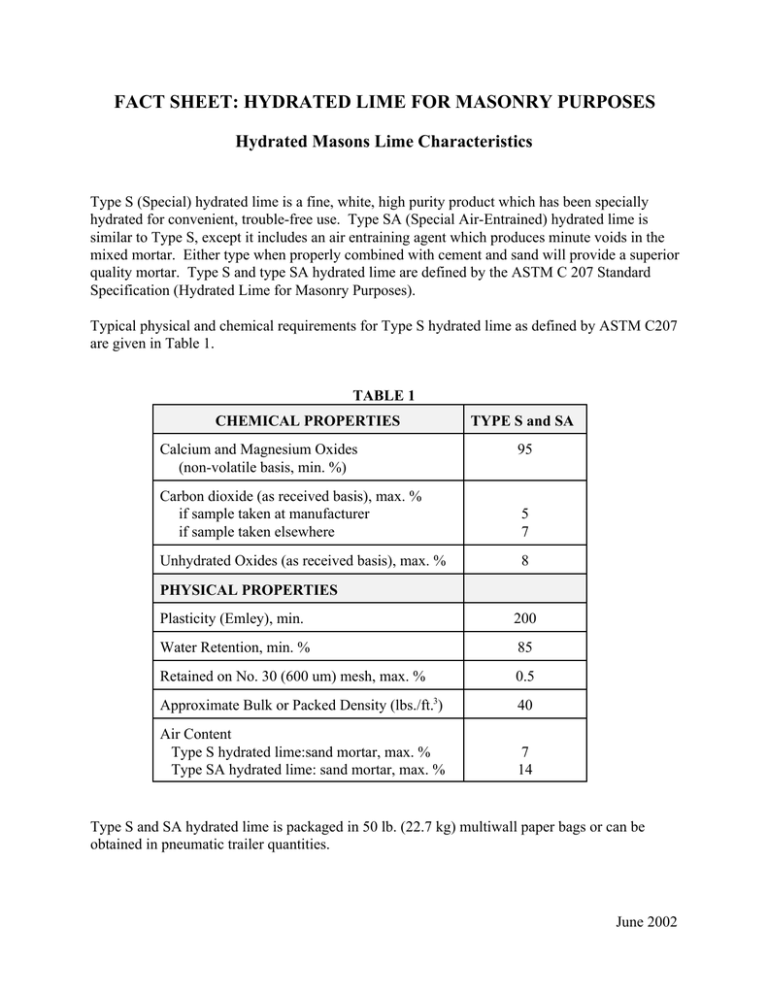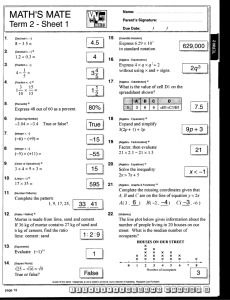Fact Sheet on Hydrated Lime for Masonry Purposes
advertisement

FACT SHEET: HYDRATED LIME FOR MASONRY PURPOSES Hydrated Masons Lime Characteristics Type S (Special) hydrated lime is a fine, white, high purity product which has been specially hydrated for convenient, trouble-free use. Type SA (Special Air-Entrained) hydrated lime is similar to Type S, except it includes an air entraining agent which produces minute voids in the mixed mortar. Either type when properly combined with cement and sand will provide a superior quality mortar. Type S and type SA hydrated lime are defined by the ASTM C 207 Standard Specification (Hydrated Lime for Masonry Purposes). Typical physical and chemical requirements for Type S hydrated lime as defined by ASTM C207 are given in Table 1. TABLE 1 CHEMICAL PROPERTIES Calcium and Magnesium Oxides (non-volatile basis, min. %) TYPE S and SA 95 Carbon dioxide (as received basis), max. % if sample taken at manufacturer if sample taken elsewhere 5 7 Unhydrated Oxides (as received basis), max. % 8 PHYSICAL PROPERTIES Plasticity (Emley), min. 200 Water Retention, min. % 85 Retained on No. 30 (600 um) mesh, max. % 0.5 Approximate Bulk or Packed Density (lbs./ft.3) 40 Air Content Type S hydrated lime:sand mortar, max. % Type SA hydrated lime: sand mortar, max. % 7 14 Type S and SA hydrated lime is packaged in 50 lb. (22.7 kg) multiwall paper bags or can be obtained in pneumatic trailer quantities. June 2002 Portland Cement or Blended Cement/Lime (CL) Masonry System Design Type S hydrated lime is a key ingredient in constructing durable, water-tight masonry. In particular, Type S hydrated lime improves mortar bond to masonry units (brick, concrete block and stone). Bond strength is important in design considerations in the prevention of cracking, water leakage, and efflorescence. Cement-lime mortars are the standard mortar of ASTM C 270. Mortars can be mixed by volume proportion of cement, lime and sand or by the property of the resulting mortar. Field mixed mortars use the proportion approach and preblended mortars use the property approach. Mortars mixed by the proportion method have a higher compressive strength than property-specified mortars (Table 2). Table 2 ASTM C 270 Standard Specification for Mortar for Unit Masonry Proportion Specification (Typical Laboratory Test Data) Property Specification* (Requirements) Mortar Designation Volume Proportions (cement:lime:sand) Compressive Strength 28 days (psi) Water Retention (%) Compressive Strength 28 days (psi) Water Retention (%) O 1:2:9 750 90 350 75 N 1:1:6 1500 85 750 75 S 1:1⁄2:41⁄2 2200 80 1800 75 75 2500 75 M 1:1⁄4:33⁄4 2800 *not applicable to field materials and conditions. Mortar strength should not exceed the strength of the masonry units. Table 3 is a general guide for CL mortar selection. Other factors to be considered include type and absorption of masonry unit, applicable building code, and engineering requirements such as allowable design stresses. Type S lime will improve water retention of mortar. High water-retentive mortars are desirable for use with high absorption units such as concrete block. Table 3 Recommended Guide for Selection of Mortar Type Exterior, above grade, load-bearing N Exterior, above grade, non-load-bearing O Exterior, above grade, parapet walls N Exterior, at or below grade S Interior, load bearing N Interior, non-load bearing O Proven Performance in Masonry Applications Of greater interest to the specifier is the performance of masonry when Type S hydrated lime is used. ASTM C 270 provides three categories of mortar: cement-lime, mortar cement and masonry cement. Cement-lime mortars are a blend of cement, lime and sand, without any additives. Masonry cements and mortar cements are proprietary products, consisting of cement, ground limestone and admixtures which enhance the plastic properties. Ground limestone is inert, unlike Type S hydrated lime which hardens with age and promotes the hydraulic reactions of the cement. University research studies comparing cement-lime and masonry cement mortars were conducted in 1987 and 1988. The research focused on masonry assemblage performance, including bond strength, shear strength, and water leakage. Medium and high compressive strength mortars were used to construct both clay brick and concrete block assemblages. Tensile bond, shear strength, and water leakage results for clay brick are given in Figures 1, 2, and 3. Assemblages made with Type S hydrated lime performed the best. Bond and shear strengths are much higher; water leakage is much lower. Only compressive strength of the prism is comparable. Tests made with 8" x 8" x 16" medium weight concrete block showed similar results. With CL mortar (containing portland cement and Type S lime), prism flexural bond strength was 70% higher than when masonry cement mortar was used. Air bag wall tests also showed higher flexural bond strength (of nearly 80%) when CL mortar assemblages were compared to masonry cement mortar assemblages. Complete reports of these studies are available from the National Lime Association. Type S Hydrated Lime in Exterior Plaster (Stucco) Type S and SA hydrated limes are highly recommended for use in three coal and two coat exterior plasters (Table 2). In exterior plaster scratch, brown and finish coats, Type S hydrated lime is used to reduce risk of cracking and improve bonding of the different applications. Its versatility is unsurpassed. It can be applied in a wide range of colors and to a wide range of decorative shapes -- curved and angular surfaces, solar screens and ornate columns. It is easily pumped as high as 200'. The result is a highly durable, water resistant wall system. Exterior Finish Mix Proportions* Portland Cement Type S or SA Hydrated Lime Sand #2 shovels (ft. 3) Yield Volume (yd3) Use Nominal Volume Proportions Scratch Coat1 1:1:6 1 bag (94 lbs.) 1 bag (50 lbs.) 30-364 (6-7) 1/5 Brown Coat2 1:1:6 1 bag (94 lbs.) 1 bag (50 lbs.) 38-424 (6-7) 1/4 Finish Coat3 1:2:9 1 bag (94 lbs.) 2 bags (50 lbs.) 50-604 (8-10) 1/3 *after ASTM C 926 Standard Specification for Application of Portland Cement-Based Plaster 1 First coat applied to base in multiple coat application. Curing with water after set required in accordance to local codes. 2 Second coat applied over scratch coat, and below finish coat. 3 Finish coat or stucco finish, exposed to exterior locations, decorative finish applied. 4 Lower range of sand for use over water absorptive concrete block, lower range used over metal reinforcing mesh with exterior sheathing or building paper. Limitations: do not use air-entraining portland cement with air-entraining Type SA lime in mortar. Type SA lime is not recommended for use with gypsum gauging plaster in gaged limeputty finishes or with Keene’s cement interior finishes. Waterproofing, plasticizing, or cold-weather additives are not recommended or required for use with cement-lime mortars. If an additive is specified, laboratory or field tests should be performed for compatibility of materials prior to approval. Such additives are non-cementitious and often can cause discoloring, efflorescence, poor workability and reduced strength. Mixing Procedure and Recommendations Bags of Type S hydrated lime should be stored in a dry place providing protection from weather, damage, deterioration, and contamination. In preparing mortar, use portland cement confirming to ASTM C 150 or blended cement conforming to C 595; clean, well-graded natural or manufactured sand conforming to ASTM C 144, and potable water that is clean and free of deleterious amounts of acids, alkalies and organic materials. Proportion ingredients accurately. A cubic foot box is preferred over a #2 shovel. Mix for at least 5 minutes in a mechanical batch mixer with the appropriate amount of water to produce a workable consistency. Too much water will result in reduction of compressive and bond strength. The recommended procedure is: ? ? ? ? ? ? ? add approximately 80% of total volume of water add total amount of sand add total amount of hydrated lime mix for 1 minute add total amount of cement add remaining volume of water mix for at least 4 more minutes Lay mortar in a uniform bed and completely fill bed and head joints. Mortar that has started to set should not be retempered or used. In cold weather construction, temperature of masonry materials should be above freezing when placed, and masonry should be protected from freezing for 48 hours after placing. Masonry should not be laid on walls or footings that are frozen or contain frost. Applicable Standards and References ? ASTM C207 Standard Specification for Hydrated Lime for Masonry Purposes. ? ASTM C 270 Standard Specification for Mortar for Unit Masonry. ? ASTM C 926 Standard Specification for Application of Portland Cement-Based Plaster. ? Brick Institute of America Technical Notes on Brick Construction 9 (revised Nov. 1989), 8A (revised Sept. 1988) and 8B (reissued Sept. 1988). ? ACI 530-95/ASCE 5-95/TMS 402-95 Building Code Requirements for Masonry Structures. ? ACI 530.1/ASCE 6-95/TMS 602-95 Specification for Masonry Structures. BUILDING LIME PRODUCERS (Nov. 2006) Chemical Lime Company 6263 North Scottsdale Road Suite 280 Scottsdale, AZ 85250-5402 Contact: David Fleming Ph: (800) 288-9676 (480) 368-4200 Fax:(480) 368-4220 e-mail: david.fleming@chemicallime.com Graymont Group P.O. Box 158 21880 West State Route 163 Genoa, OH 43430-0158 Contact: Mike Tate Ph: (419) 855-8336 (800) 537-4489 Fax: (419) 855-4602 e-mail: mtate@graymont-oh.com Mississippi Lime P. O. Box 2247 Alton, IL 62002-2247 Ph: (618) 474-2826 Fax: (618) 465-7786 Contact: Dan Okenfuss e-mail: djokenfuss@mississippilime.com Rockwell Lime Co. 4110 Rockwood Road Manitowoc, WI 54220 Contact: Joe Brisch Ph: (920) 682-7771 (800) 558-7711 Fax: (920) 682-7972 e-mail: joebrisch@rockwelllime.com Western Lime Corp. P.O. Box 57 West Bend, WI 53095 Contact: Biju Daniel Ph: (262) 334-3005 (800) 433-0036 Fax: (262) 334-2874 email: bdaniel@westernlime.com



